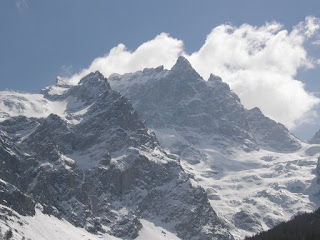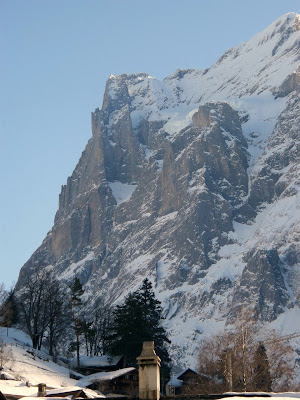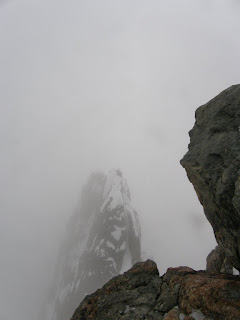'I'll take one road from here on in...' - Woodie Guthrie
Above: Morning cumulus boils up alongside the northernmost peaks of the Ecrins, as we look down from 3,600m at our tracks in the spring sunshine.
The signs were not good, as I drove toward Grenoble - a week of punishing hayfever had laid me so low as to be subterranean and very much sick at home, and as of two o'clock in the morning on Friday I had developed a bad head cold on top. Arriving in La Grave on Saturday afternoon, I checked into the two-star Castillan hotel and promptly crashed out under a blanket for two or three hours, the best sleep I had had for days.
When I pulled myself together towards six o'clock, and stepped out into the street, the weather was perfect and the north face of La Meije towered above miles of blue-white glacier in a teetering pinnacle of rock and snow, while thick plumes of cloud rose from the southern side. It was the most impressive scene I could have wished for, as I soaked up the sunshine on the patio of the Pierre Farabo restaurant, took photograph upon photograph and polished off spaghetti bolognese followed by apple pie and a bowl of hot chocolate.

Above: La Meije with the Grand Pic (3,982m) clearly visible against the clouds which were a feature of the spring weather all weekend. Surprisingly, the north face receives little attention from alpinists these days, but it offers exciting and difficult mixed climbing possibilities in contrast to the rock walls of the mountain's south face.
But we were not here to climb La Meije, inspired though we were by the tremendous views and calm weather. We were here for Le Rateau - the twin summits of which rise to 3,809m and 3,766m respectively out of a long crenellated ridge resembling the razor teeth of a mantrap. In summer, the north-west arete would offer a pleasant ridge climb on red-brown granite and a chance to take in panoramic views of the whole Ecrins massif - this being along with La Meije, one of the most northerly peaks of significance in the range.
Above: The north face of Le Rateau and the east summit (3,809m) seen from nearly 2.5km below in La Grave. Like all of the northernmost peaks of the Ecrins, it is wonderfully glaciated, fearsome seracs barring the approach to the north-east col.
All night I attempted to sleep but a mixture of illness and anticipation provided more than ample fuel for an insomniac experience. At one point, I recall saying out loud 'Toni, es geht los,' an infamous line from the movie Nordwand where Hinterstoisser announces that the clouds are disappearing...noises from the floor above finally woke me up at half past seven, and I limped down the carpeted stairs of the Castillon to a breakfast of croissants with nutella, and one under-boiled egg.
Above: Approaching 3,000m via the cable car, the scale of the mountains begins to dawn on us as we near our jumping-off point for the climb on the Rateau glacier.
Boris, who had just arrived from Moscow the day before, and looked about as off-colour as I did after a week in the urban pollution, performed some emergency repairs on his boots with the aid of some steel wire, as we enjoyed the long cable car ride from La Grave to near the top of the ski slopes. Occasionally, the cars stopped - presumably while the crew unloaded the crates of eggs and champignons we had seen crammed into the first run of the day. I took in the preposterous views of La Meije while the stationery cars wobbled on their cables in the light breeze.
We exited into the ski area a little incongruously, wearing snow shoes and waddled a short distance along the piste. Here, beside a small 'danger' sign we roped up on an 8mm cord and stepped off the pisted track onto a shallow-angled snow slope. So subtle was the terrain, so immaculate, that one could be forgiven for not realising that we were now on top of the glacier - from here to the col at 3,500m we were treading on crevassed terrain, where only the largest apertures were visible. How many crevasses we trod on, light as feathers in our snow-shoes, six metres of tense rope between us, I will never know unless I go back in summer and count them...
Slowly, we climbed the approach slopes to the Col de la Girose without incident, passing over a large crevasse covered in enough snow to wade through without falling in. The final slope was steeper and we removed our snow shoes to deal with it, re-donning them near the col to coast smoothly over the easier-angled (but still invisibly crevassed) slopes. By this time, the mountain had become enveloped in the cumulus clouds which had received an innocuous mention in the otherwise spotless weather bulletin ('cumulus may cause isolated problems in some areas', or some such remark).
Above: Boris just below the start of the mixed ground, during the last spell of clear weather. A pleasant scramble in summer conditions, the ridge would confront us with increasingly difficult mixed climbing on snow over rock, in proportion to the height gained. Our route followed close to where the cloud can be seen converging with the ridge.
Above: High on the ridge, in low visibility. To the right of the snow-crest is a 600m sheer drop down the north face, to the left a similar abyss down to the Selle glacier - in a way, we were thankful we could see neither.
Above: On a knife-edge. Looking back on what we have just climbed from around 3,700m and beginning to wonder how we will reverse the passage. By this stage, the ridge had become a series of impressive granite gendarmes, which we had no option but to climb direct. In summer, parties can cut around these difficulties on the south side of the ridge. Soft, unprotectable snow slopes ruled out this option.
Above: A rock gendarme offers the only route to the summit. We climbed two of these wet granite towers consecutively with mountain boots and rucksacks, in a mild snowstorm at IV+ and V. Before I got used to the freezing effect of the snow, my fingers quickly went numb and I could feel my one hand start to slip as I tried to warm my other while balancing on wet, sloping footholds. Once I got past the cold, the climbing became enjoyable.
Above: Snow or sky? Manouvering between gendarmes, a brief clearing in the storm affords us a view north. We were negotiating the thinnest section of the ridge by now, a few metres below the final summit crest.
Above: The final gendarme tapers into abyss and cloud, caked with fresh snow. I remember climbing the right-hand side of it confidently and rationally - the footholds in particular were very small for my large mountain boots and I had to trust them constantly in order to progress.
The muffled sound of metal on metal rang out along the ridge as I waited and watched snow accumulate on my jacket and gloves as I belayed once more into the mist. Somewhere up ahead, Boris was hammering in a piton and each blow reverberated along the ridge. The emptiness of the south face was scarcely visible in the storm.
As I surmounted the final gendarme just below the ridge-top, I noticed a narrow snow crest come suddenly level with my face as I pulled up. There was a puncture hole going right through the snow - and into thin air. I was looking straight through the ridge, and down the north face. The drop was about a foot away. Carefully, I contoured along the south side, on wet slabby rock, to where Boris huddled in an improvised rock belay.
We discussed the situation. We were perhaps 20 metres short of the summit, and from here the ridge was flat. However, Boris recalled, it was strewn with loose blocks which were now covered in snow, and the whole passage would be immediately on top of the north face. The decision was an easy one: we were not going on. Somewhat relieved, we shook hands on our 'technical summit' and prepared to abseil down the south face. By so doing, we could regain the ridge lower down, admittedly by crossing the rather intimidating snow slopes below the gendarmes - but by now, it was our only escape route.
Above: Jubilation on the 'technical summit' of Le Rateau at around 3,750m, although we knew all too well that a delicate and precarious descent was ahead of us, as well as the need to get down from the Col de la Girose as quickly as possible, given the accumulation of fresh snow.
Above: Rapping the Rateau. Boris leads the abseil retreat from the summit ridge into the mists of the south face. We descended 50m and traversed round the large gendarme via a delicate snow slope, partially visible to the right of the photograph below. Plunging one ice axe full-handle into the snow, I would punch my other hand into the snow and clinging on, gingerly traverse round, trying not to stare into the bottomless gully beneath me...
Above: About to reverse the lower section of the ridge, where we moved together, looping the rope over the obvious rock 'spikes' to afford some measure of protection on the way down. Reversing this long arete of snow-covered rock and thin exposed snow-crests over steep gullies always threatened to unnerve me, but never quite succeeded!
Above: Safely down and off the glacier, we look back at the ridge which now bears a plastering of fresh snow from the day's storm, the cloud which plagued our ascent having retreated to the south.
Above: To the victor, the spoils - about to enjoy more spaghetti at the excellent Pierre Farabo back in La Grave, while the north face of La Meije beckons into the future.
As I drove back through the Romanche Valley toward Grenoble, reflecting on the risks we had taken (eating the under-boiled egg) and the lessons we had learned (never to trust a weather bulletin), I stopped the car for a few moments to appreciate the French Resistance memorial in Oisans. Alpinism is seen by many as an especially bold form of recreation, even foolhardly. Perhaps because we were out to enjoy our climb, and were not motivated by taking a summit at any cost, our climb felt remote from this perception.
I mused on the significance of alpinism as I stood beside the road. True, alpinism was a thing to be enjoyed, and if it was something to be admired then so much the better, but my feeling is that the sentiment of admiration would be better directed at those whose names are remembered in the shade beneath the sun-flecked walls of the Romanche Valley, and who set us off on our roads to freedom.

















































